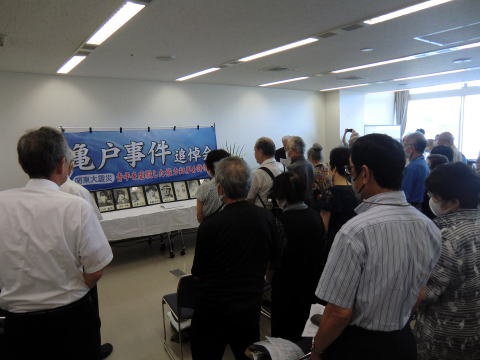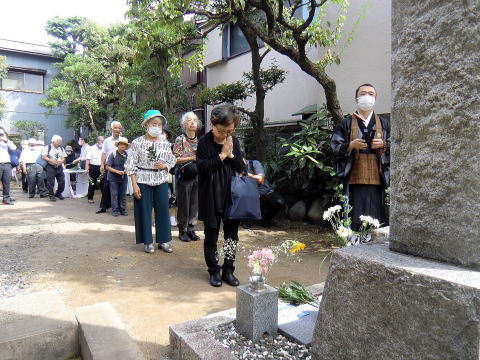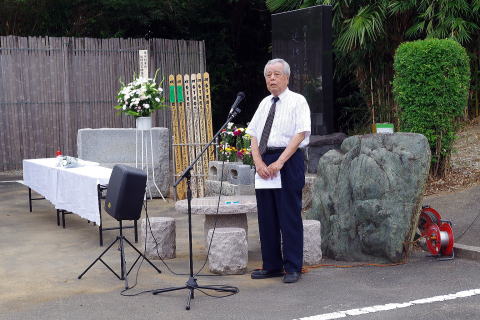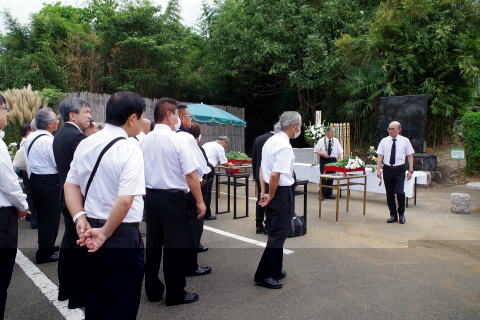

=関東大震災から100年経った今、あらためて当時のデマと妄信を考える=
私が子どものころ、祖母から関東大震災の直後に「朝鮮人が暴動を起こした。」「井戸に毒を入れた」などの噂があったことを聞いたことがある。
「検見川事件」と「福田村事件」、震災直後に起こったこの事件は、デマと妄信そして、偏見と差別によって引き起こされたもので犯行を重ねた自警団員と傍観した市民。
これを機に100年前に起こった事件を鑑み現代社会の様々な偏見と差別感情を考えてみよう。
「検見川事件」(けみがわ:現、千葉市検見川区)
震災から4日後の9月5日に発生。被害者は沖縄県、秋田県、三重県の20代の男性で震災後東京から旧花見川を渡って避難してきた3人が自警団によって「言葉のなまり」から異質な存在として軽視され朝鮮人と間違われ、虐殺されて死骸を花見川に投棄した事件。その後「幕張事件」などとも呼ばれ、裁判の結果、事件団の10人が有罪になった。
※「検見川事件」を調査し自費出版した沖縄県出身の島袋和幸氏は、「被害者の1人が、ウチナンチュー(沖縄人)だった」からだという。「言葉のなまりから異質の存在と見られたのだろう。事件は在日朝鮮人のほか、琉球人ら地方出身者への偏見の問題もはらんでいる。沖縄にとっては今も続いている差別の表れだ。」
「福田村事件」
関東大地震から5日後の9月6日に発生。千葉県東葛飾郡福田村(現:野田市)に住む自警団を含む100人以上の村人たちにより、利根川沿いで香川県から訪れた薬の行商、男女15人の内、幼児や妊婦を含む9人が暴行され利根川に投げ込まれ殺された。行商団は、聞きなれない讃岐弁で話していたことで朝鮮人と疑われ殺害されたのだ。逮捕されたのは自警団員8人。逮捕者は実刑になったものの、大正天皇の死去に関連する恩赦ですぐに釈放された…。
この同胞を殺害した二つの事件は、震災直後に拡大した「朝鮮人が暴動を起こした」のデマを信じ込んだ自警団の暴走だった。いや、それだけでなく見て見ぬふりをした一般市民の責任もある。
震災後の混乱と不安の中、
今の時代でもSNSによる偽情報と偽映像、私たちは、100年前のこの事件を教訓にできるのか? 個である我々が社会正義の為に、集団に意義を唱えることが出来るのだろうか? いや、勇気をもって、しなければならない。
Now, 100 years after the Great Kanto
Earthquake, I once again think about the rumors and false beliefs of those
days.
When I was a child, I heard rumors from my
grandmother that immediately after the Great Kanto Earthquake, ``Koreans
rioted,'' and ``poisoned wells.''
Her grandmother didn't say more, but two
incidents have come to the fore in the 100th anniversary of the disaster.
The "Kemigawa Incident" and the
"Fukuda Village Incident", which occurred immediately after the
earthquake, were caused by hoaxes, false beliefs, prejudice and discrimination.
Taking this opportunity, I tried to think
about various prejudices and discriminatory feelings in modern society in light
of the incident that happened 100 years ago.
"Kemigawa Incident" (Kemigawa:
now Kemigawa Ward, Chiba City)
It occurred on September 5, four days after
the earthquake. The victims were men in their twenties from Okinawa, Akita, and
Mie prefectures. Three of them, who had evacuated from Tokyo by crossing the
old Hanami River after the earthquake, were mistaken for Koreans by the
vigilante group because of their dialect. An incident in which he was
slaughtered and dumped his corpse in the Hanami River. After that, it was
called the "Makuhari case", and as a result of the trial, 10 members
of the case group were found guilty.
"Fukuda Village Incident" Fukuda Village, Higashi Katsushika District, Chiba Prefecture (currently Noda City)
It occurred on September 6, five days after
the Great Kanto Earthquake. More than 100 villagers, including vigilantes
living in Fukuda Village, Higashi Katsushika County, Chiba Prefecture (now Noda
City), assaulted 15 men and women from Kagawa Prefecture along the Tone River.
Nine people, including infants and pregnant women, were thrown into the Tone
River and killed.
The peddlers were suspected of being
Koreans and were killed because they were speaking in an unfamiliar Sanuki
dialect. Eight vigilantes were arrested. The arrested person was sentenced to
prison, but was soon released under an amnesty related to the death of Emperor
Taisho.
These two incidents were the rampage of
vigilante groups who believed the rumor that "Koreans caused a riot"
that spread immediately after the earthquake. No, not only that, but also the
responsibility of ordinary citizens who turned a blind eye.
All victims were from rural areas far from
Tokyo where they could not speak standard Japanese.
<関東大震災>
1923(大正12)年9月1日正午ごろ、相模湾北西部を震源としたマグニチュード(M)7.9の地震が発生。建物の倒壊や火災、津波、土砂崩れなどが各地で頻発し、死者・行方不明者は約10万5000人に上った。
混乱の中で「朝鮮人が暴動を起こす」とデマが広がりがった。テレビもラジオもない時代の唯一の情報源は新聞。その新聞も、多くのデマの根拠も示さず、人々に不安をあおった。
※10万5000人(犠牲者)の内、殺害された朝鮮人などは1~数%(内閣府 中央防災会議報告書)
<Great Kanto Earthquake>
Around noon on September 1, 1923 (Taisho 12),
an earthquake of magnitude (M) 7.9 occurred with its epicenter in the
northwestern part of Sagami Bay. Buildings collapsed, fires, tsunamis, and
landslides occurred frequently in various places, and about 105,000 people died
or went missing. Amidst the chaos, rumors spread that Koreans would cause
riots, and many Koreans living in Japan were massacred. Some of the victims
were Chinese and Japanese.
<当時の日本人が抱く朝鮮人に対する感情>
同胞の虐殺事件以外に、震災直後の恐怖と不安、当時の日本人が抱いていた朝鮮人に対する「ある感情」。日本は
<Feelings towards Koreans held by Japanese people at the time>
In addition to the massacre of compatriots, there is also the fear
and anxiety immediately after the earthquake, and the ``certain feelings''
Japanese people had toward Koreans at the time. Japan annexed Korea in 1910,
and after that, Koreans began moving to Japan in search of work.
On the other hand, the independence movement intensified on the
Korean Peninsula, and news of this movement was transmitted to Japan, causing
many Japanese people to fear and develop a sense of discrimination.
The Japanese call Koreans who engage in anti-colonization activities
``riots'' and say they are violent people.
<大震災直後の自警団による、その他の事件
「検見川事件」と「福田村事件」の他に、以下の事件も起きていた!
Other incidents during the earthquake disaster In addition to the ``Kemigawa Incident'' and the ``Fukuda Village Incident,'' the following incidents also occurred.
<本庄事件>(埼玉県本庄市)
本庄事件は、1923年9月4日に起きた朝鮮人殺害事件。
埼玉県でも同様に自警団が組織され、県内全域で朝鮮人狩りが行われ、暴力行為にエスカレートしたことで死傷者が出るようになった。そして、100名ほどの朝鮮人が亡くなったとされている。しかし、ほとんどの事件で軽い罪に問われる、もしくは証拠不十分で無罪とされた。
<Honjo Incident >(Honjo City, Saitama Prefecture)
The Honjo Incident was a murder of Koreans that occurred on
September 4, 1923.
Immediately after the earthquake, various rumors were circulating,
including rumors such as ``Koreans causing a riot'' and ``Koreans poisoning the
well.'' Because of this fear, vigilante groups were formed around fire
departments in various parts of the Kanto region.
A similar vigilante group was organized in Saitama Prefecture and
hunted Koreans throughout the prefecture, escalating into violent acts that
resulted in casualties. It is believed that about 100 people died.
However, in most cases they were charged with minor crimes or were
acquitted due to insufficient evidence.
<藤岡事件>(群馬県藤岡市)
関東大震災直後の9月5~6日に「朝鮮人が暴動を起こす」「井戸に毒を入れた」という流言を信じた自警団ら市民が、当時の藤岡警察で保護されていた朝鮮人17人を日本刀や猟銃で虐殺した事件。「群馬県警察史」によると警察は殺人などの容疑で37人を摘発し大半が有罪判決を受けた。
<Fujioka Incident> (Fujioka City, Gunma Prefecture)
This incident occurred on
September 5th and 6th, immediately after the Great Kanto Earthquake, when
vigilante groups and other citizens believed the rumors that ``Koreans were
rioting'' and ``poisoning wells.'' This is an incident in which 17 people were
massacred.
According
to the Gunma Prefectural Police History, police arrested 37 people on suspicion
of murder and other crimes, and most were convicted.
震災の混乱に乗じた思想弾圧と労働運動家の根絶
Ideological suppression and eradication of labor activists taking
advantage of the chaos caused by the earthquake
<亀戸事件> =労働運動の芽をつぶす権力犯罪=(現:東京都江東区亀戸)
震災直後、混乱の中で戒厳令が布告され、官民一体のお達し:当時の内務省から各自治体への電報
その混乱に乗じて、9月3日、日本の社会主義者、労働運動の指導者など10名が亀戸警察に連行され、軍隊により虐殺された。これは当時の世相を背景にして、震災の混乱に乗じた思想弾圧と労働運動家を根絶するための権力犯罪である。
<Kameido Incident> = Power crime that killed the buds of the
labor movement =
Immediately after the
earthquake, martial law was declared in the midst of confusion, and the public
and private sectors jointly issued a message: The then Ministry of the Interior
sent a telegram to each local government, organizing vigilante groups to
"report the Korean riots as a fact and carry out strict crackdowns."
"and
This provided support for the country to heighten its vigilance. lIn
an era without television or radio, newspapers were the only source of information.
The newspaper also did not provide any basis for many of the false rumors,
stirring up fear among the people.
Taking advantage of the chaos, on September 3, 10 people, including
Japanese socialists and labor movement leaders, were taken by the Kameido
police and massacred by the military. This was a crime of power that took
advantage of the chaos caused by the earthquake to suppress ideas and eradicate
labor activists against the backdrop of the social conditions at the time.
<甘粕事件(あまかす事件)>(大杉事件=思想家 弾圧事件)東京都
1923年9月16日,甘粕正彦憲兵大尉が大杉栄夫妻を殺害した事件
関東大震災の混乱の際に,東京憲兵隊特高課の分隊長 甘粕らは,アナキストである大杉栄・内妻の伊藤野枝と甥の橘宗一を外出先で、拘束し、淀橋警察署(現:新宿警察署)から麴町憲兵司令部(現:千代田区麹町)に連行し、虐殺した。大杉は平民社の参画などで知られており、また伊藤は女性解放運動家の平塚らいてう(らいちょう)の青鞜社に関わった事でも知られている。
分隊長であった甘粕正彦憲兵大尉の責任とされたが、実際には上級の命令者がいたと推測されている。
※雑誌「青鞜」:日本初の女性による女性の為の文芸雑誌として、平塚らいてう が中心となり創刊した月刊誌。1911~16年に発行された。家父長制に抵抗した、らいてう
は、創刊の辞で「元始、女性は実に太陽であった」と唱えた。1915年から伊藤野枝が編集兼発行人を務めたが、資金難などの為に解散した。
1923年12月26日の大杉の葬儀の際、遺骨が右翼団体 大化会の岩田富美夫らに奪われた。その報復のため無政府主義者古田大次郎(ふるただいじろう)らは翌1924年9月1日、福田雅太郎大将狙撃(そげき)事件を起こした。大杉の死によりアナキズム運動は大打撃を受けることになった。
<Amakasu Incident = Osugi Incident => Tokyo Prefecture
Taking advantage of the confusion caused by the Great Kanto
Earthquake, on September 16, 1923, Amakasu, a squad leader of the Tokyo
Military Police Special High School Division, arrested the anarchist Osugi
Sakae, his wife Noe Ito, and his nephew Soichi Tachibana.
This is the incident in which they were subsequently murdered.
Osugi is known for his involvement in Heiminsha, and Ito is also known for his involvement in Hiratsuka Raicho's Seikasha.
Military Police Captain Masahiko Amakasu, who was the squad leader,
was blamed, but it is speculated that there was actually a higher-ranking
commander. Amakasu was sentenced to 10 years in prison at a military court, but
was released in October 1926 and became the top official of the Manchukuo Union
Association. (Source: Obunsha Japanese History Dictionary, 3rd edition)
During Osugi's funeral on December 26, 1923, his remains were stolen
by Fumio Iwata and others from the right-wing group Taikakai.
In retaliation, anarchist Daijiro Furuta and others committed the
sniping incident of Gen. Masataro Fukuda on September 1, 1924. Osugi's death
dealt a major blow to the anarchist movement.
※日本政府はこれらの事件を、今なお、この事実の全貌を明らかにせず、加害責任を認めていない。
混乱と恐怖の中、私たち誰もが不安の中で「自分を守る、家族を守る、地域を、町を、さらには国を守る為」と、大義をかざして、群集心理の中、誤った行動、犯罪をしてしまう。皆、善人のはずだが、デマと妄信により、そして、見て見ぬふりをして犯罪に加担してしまう。そして、混乱に乗じた政府の思想弾圧。
The Japanese government still has not revealed the full facts of
these incidents and has not acknowledged responsibility for the perpetrators.
In the midst of confusion
and fear, in the midst of anxiety, all of us hold up a good cause, ``to protect
ourselves, protect our families, protect our region, our town, and even our
country.'' or commit a crime.
They are all supposed to be good people, but through false rumors
and delusional beliefs, they become complicit in crimes by turning a blind eye.
In addition, the government has taken advantage of the chaos to
suppress ideas, which is why we must study history thoroughly and apply its
lessons to the present day.
2023年9月1日(金)=関東大震災100周年 朝鮮人犠牲者追悼式典= 墨田区横網町公園
1923年9月1日11:58に起こった関東大震災から100年を迎えた追悼式典。
墨田区横網町公園に、大震災の直後に虐殺された朝鮮人らを追悼するため1973年に立てられた追悼碑、「追悼 関東大震災朝鮮人犠牲者」、碑文「この歴史 永遠に忘れず 在日朝鮮人と固く 手を握り 日朝親善
アジア平和を 打ちたてん」
74年から追悼式典が催されてきた。今年は日朝協会などによる実行委員会が9月1日午前11時から、会場に入りきれない程の参加者多数で開催した。
主催者である9.1関東大震災朝鮮人犠牲者追悼式典実行委員会は「アジアと世界の平和と安定に寄与することを願い震災における犠牲者の追悼とこのような歴史を繰り返さない決意を込めて追悼式典を行います。」と述べ、
一方、朝鮮人虐殺の事実を疑問視し、過去に集会の発言がヘイトスピーチ発言と認定された団体「日本女性の会 そよ風」は、追悼碑に刻まれた犠牲者数「6千余名」を「根拠がない」と主張し、碑の撤去を2016年から要求。17年から公園内の別の慰霊碑前で、日朝協会と同じ1日午後に「真実の慰霊祭」と称する集会を催してきた。この日も、追悼碑の前で集会しようとすると、集会に反対する人たちから「帰れ」とのシュプレヒコールがあがった。
100年前の関東大震災後、デマにより殺害された数千の朝鮮人犠牲者と700人以上の中国人が、当時の軍隊や警察、自警団によって虐殺された。
100th Anniversary of the Great Kanto Earthquake Memorial Ceremony for Korean
Victims September 1, 2023 (Friday) Yokoamicho Park, Sumida Ward
This year marks the 100th anniversary of the Great Kanto Earthquake that occurred at 11:58 on September 1, 1923. "Memorial: Korean Victims of the Great Kanto Earthquake" is a memorial monument erected in Yokoamicho Park in Sumida Ward in 1973 to commemorate the Koreans who were massacred immediately after the Great Earthquake. The inscription reads, ``We will never forget this history, and we will firmly hold hands with Korean residents in Japan and build goodwill between Japan and North Korea and peace in Asia.''
Memorial ceremonies have been held in front of this memorial monument since
1974. This year, the executive committee consisting of the Japan-North
Korea Association and others held the event from 11 a.m. on September 1st.
In the hope of contributing to peace and stability in Asia and the world,
we will hold a memorial ceremony to remember the victims of the earthquake
and to express our determination not to repeat such history. (September
1 Great Kanto Earthquake Memorial Ceremony Executive Committee for Korean
Victims)
There were sutra readings, a requiem dance, condolence speeches from all
walks of life, memorial messages, a moment of silence (at 11:58), and floral
offerings. On the other hand, the group ``Japanese Women's Association
Soyokaze'', which questions the fact of the massacre of Koreans and whose
rallies have been certified as hate speech in the past, claims that the
6,000-baseless number of victims inscribed on the memorial monument is
The name has no basis They have been demanding the monument's removal since
2016. Since 2017, they have been holding a gathering called the ``True
Memorial Service'' in front of another memorial in the park on the same
morning as the Japan-North Korea Association. On this day as well, when
people tried to gather in front of the memorial monument, people who opposed
the gathering shouted at them to "go home."
After the Great Kanto Earthquake 100 years ago, thousands of Korean victims
and more than 700 Chinese people were massacred by the army, police, and
vigilante groups of the time.












<都立横網町公園>












2023年9月3日(日)<関東大震災100周年 亀戸事件追悼会>(江東区亀戸)
=労働運動の芽をつぶす権力犯罪=
震災直後、混乱の中で戒厳令が布告され、官民一体のお達し:当時の内務省から各自治体へ電報を打ち、自警団を組織して「朝鮮人の暴動を事実として伝え厳密なる取り締まりを」と、国が警戒心を高める後押しをした。
テレビもラジオもない時代の唯一の情報源は新聞。その新聞も多くのデマの根拠も示さず、人々に不安をあおった。
その混乱に乗じて、9月3日に当時の特高警察は、震災の被害者救済活動をしていた日本の社会主義者、労働運動の指導者など10名が亀戸警察署に連行され監禁、戒厳司令部直轄軍隊により虐殺された。
Ideological suppression and eradication of labor activists taking
advantage of the chaos caused by the earthquake
<Kameido Incident> = Power crime that killed the buds of the labor
movement
Immediately after the earthquake, martial law was declared in the midst
of confusion, and the public and private sectors jointly issued a message:
The then Ministry of the Interior sent a telegram to each local government,
organizing vigilante groups to "report the Korean riots as a fact
and carry out strict crackdowns." "an
This provided support for the country to heighten its vigilance. lIn an
era without television or radio, newspapers were the only source of information.
The newspaper also did not provide any basis for many of the false rumors,
stirring up fear among the peopl
Taking advantage of the chaos, on September 3, 10 people, including
Japanese socialists and labor movement leaders, were taken by the Kameido
police and massacred by the military. This was a crime of power that took
advantage of the chaos caused by the earthquake to suppress ideas and eradicate
labor activists against the backdrop of the social conditions at the time.
これは当時の世相を背景にして、震災の混乱に乗じた思想弾圧と労働運動家を根絶するための権力犯罪である。
1970年9月に亀戸の赤門浄心寺に「亀戸事件犠牲者之碑」を建立し、毎年9月に追悼会を実施している。
今年は9月3日に亀戸事件追悼実行委員会主催で亀戸駅近くの亀戸文化センターで約70名の参加者で行われ、経過報告、追悼の言葉、メッセージ、黙祷、そして労働歌「南葛労働者の歌」をアコーディオンの伴奏で、参加者全員で合唱した。
追悼会後、参加者は「亀戸事件犠牲者之碑」に出向き、読経、献花し犠牲者の冥福を祈った。
This was a crime of power that took advantage of the chaos caused by the
earthquake to suppress ideas and eradicate labor activists against the
backdrop of the social conditions at the time. In September 1970, the ``Monument
to the Victims of the Kameido Incident'' was erected at Akamon Joshinji
Temple in Kameido, and a memorial service is held every September. This
year, it was held on September 3rd by the Kameido Incident Memorial Executive
Committee at the Kameido Cultural Center near Kameido Station with about
70 participants. There were progress reports, words of condolence, messages,
a moment of silence, and all participants sang the labor song ``Nankatsu
Workers' Song'' to the accompaniment of an accordion. After the memorial
service, participants went to the Kameido Incident Victims Monument, read
sutras, laid flowers, and prayed for the souls of the victims.


















<詳細:亀戸事件>1923.9.3
=震災で行方が消えた青年十人は、警察と軍隊に銃剣で殺された 。 混乱の中で青年たちを殺害 =
震災の混乱のなかで戒厳令が布告された中、南葛地域(現在の江東区・墨田区)では、被災者救援のため活動していた川合義虎(日本共産青年同盟初代委員長)や平沢計七(純労働者組合)をはじめ労働組合の青年幹部など10名が、亀戸警察署に連行され、軍隊の手で虐殺された。
この事件は、日本の労働運動の発祥地、拠点であった亀戸で、その革命的精神を双葉のうちにつみとろうとした権力犯罪である。
社会主義者であった平沢計七・川合義虎・加藤高寿、北島吉蔵、近藤広蔵、佐藤欣治、鈴木直一、山岸実司、吉村光治、中筋宇八の10名が亀戸警察署によって捕らえられ、9月3日から翌4日にかけて帝国陸軍の騎兵第一旅団の中の一つである習志野騎兵第13連隊によって刺殺された事件だ。
殺害現場は亀戸警察署内か荒川の放水路にて殺されたとされている。
なお陸軍が関与したきっかけは川合らが留置所で扇動する可能性があったため、近くに駐屯していた軍に警察が応援を求めたためとされている。
亀戸事件追悼会実行委員会は、亀戸事件の真相と権力の責任を追及し、1970年には、江東区亀戸にある赤門浄心寺に多くの団体、個人の協力を得て、「亀戸事件犠牲者之碑」を建立した。
①亀戸事件の被害者
殺された10名のうち、平沢計七と中筋宇八を除いた8名は南葛労働協会のメンバーであった。
彼らは広瀬自転車で起きた争議などにおいて様々な活動を行っており、攻撃的であったため、亀戸警察にマークされている存在だった。
特に川合は若くして共産活動家として行動力があり、日本共産青年同盟(後の日本民主青年同盟、民青)の委員長でもあった。
大震災が起きた際に、南葛労働協会の人間は被災者救援活動を行っていたとされている。
平沢計七は劇作家としても知られていて、プロレタリア演劇の第一人者で南葛労働協会の人間ではなかったが、純労働者組合という組織を結成し代表として様々な労働運動に関わっていた人物であった。
亀戸事件によって10名の無実な市民が殺害されたが、この事件がすぐに明らかになる事はなかった。
事件発生の1カ月後に警察が認めた事もあり、遺族・犠牲者の友人・関係者らによる糾弾活動が行われた。
震災直後の混乱の中で亀戸事件に類似する事件や、数多くの殺傷事件があったとされている。
なお、これらの事件はどれも責任追及が進むことは無かった。
大震災後、社会的に軍部や政府、警察の活動として被災者の救済に加え、治安維持が求められたため、むしろ軍部の行動は歓迎されていた。
また、自警団による犯罪は「愛国心」によるとして情状酌量される事となった。
震災後の混乱によって生じた事件で殺害された人数は、吉野作造氏の調査によると2600人とされていますが正確にはわかっていない。
そして、日本政府はこれらの事件を、今なおこの事実の全貌を明らかにせず、加害責任を認めていない。
この事件は、日本の労働運動の発祥地、拠点であった亀戸で、その革命的精神を双葉のうちにつみとろうとした権力犯罪です。
亀戸事件は思想弾圧の権力犯罪だが、朝鮮人・中国人虐殺そして、方言による差別意識からの同胞の殺害は、震災直後の混乱と恐怖の中、当時の内務省のお達し「朝鮮人を…。自警団を組織せよ…。」と、デマの裏付けも取らずに記事を書き発行した新聞の影響の大きさ、私たち誰もが不安の中で「自分を守る、家族を守る、地域を、町を、さらには国を守る為」と、大義をかざして、群集心理の中、誤った行動、犯罪をしてしまう。皆、善人のはずだが、デマと妄信により、そして、見て見ぬふりをして犯罪に加担してしまう。
※亀戸事件 - Wikipedia
2023年9月6日(水)「関東大震災 福田村事件100年 犠牲者追悼式」(千葉県野田市)
1923年9月1日11時58分、関東大地震が発生した。そのわずか5日後の9月6日のこと。千葉県東葛飾郡福田村に住む自警団を含む100人以上の村人たちにより、利根川沿いで香川から訪れた薬売りの行商団15人の内、幼児や妊婦を含む9人が殺された。行商団は、讃岐弁で話していたことで朝鮮人と疑われ殺害されたと言われている。
一方で、福田村事件追悼慰霊碑保存会は、「被害にあった行商の一行は、被差別部落の方々でした。事件が引き起こされた背景には、民族差別、部落差別、職業差別などが交差した、いわゆる「複合差別」があると考える。」と言う。
逮捕されたのは自警団員8人。逮捕者は実刑になったものの、大正天皇の死去に関連する恩赦ですぐに釈放された…。
私たちは、行き交う情報に惑わされ生存への不安や恐怖に煽られたとき、集団心理は加速し、群衆は暴走する。これは単なる過去の事件では終われない、今を生きる私たちにも当てはまる。
追悼式は、大利根霊園にある「福田村事件 追悼慰霊碑」前で行われ、円福寺の住職による読経、参列者の焼香、献花が行われた。今年は初めて犠牲者の出身地 香川県の職員の参列もあり、厳かに行われた。参加者は推定で80人位であった。
大きな追悼慰霊碑のそばには卒塔婆もある。慰霊碑の裏側には亡くなった人の名前や年齢が刻まれている。「胎児」との文字もあり、生々しさが伝わってくる。事件から80年の日に建ったこの碑は、その間の重みを背負って立っている。
また、2023年6月20日、野田市の鈴木有市長は市議会一般質問の答弁で、事件が100周年となることについて触れ「被害に遭った人たちに謹んで哀悼の誠をささげたい」と弔意を示した。同市が公式の場で事件の被害者に対して哀悼の意を表したのは初めてであった。
行商団15人の内6人が助かったとされる「香取神社」(三堀香取神社)は、慰霊碑から5分ぐらいの所にあり、とても古そうな神社だ。この鳥居のところにいた6人は助かった。そして、9人が殺されたのは鳥居から少し離れた所の当時店があったところだという。
Wednesday, September 6, 2023 “Great Kanto
Earthquake Fukuda Village Incident 100th Anniversary Memorial Ceremony for
Victims” (Noda City, Chiba Prefecture)
At 11:58 on September 1, 1923, the Great Kanto Earthquake occurred.
It was September 6th, just five days later.
It is said that the group of peddlers were suspected of being Korean
because they spoke in the Sanuki dialect, and were killed.
On the other hand, the Fukuda Village Incident Memorial Cenotaph
Preservation Society stated, ``The group of peddlers who suffered the damage
were members of a discriminated Buraku community.The incident was caused by
ethnic discrimination, Buraku discrimination, occupational discrimination, etc.
I believe that there is so-called "complex discrimination" that intersects
with each other. ” he says.
Eight members of the vigilante group were
arrested. Those arrested were sentenced to prison, but were soon released under
a pardon related to the death of Emperor Taisho.
When we are confused by the information that comes and goes and are
stirred up by anxiety and fear for our survival, the collective psychology
accelerates and the crowd goes out of control. This applies not only to past
events but also to those of us living in the present.
The memorial service was held
in front of the Fukuda Village Incident Memorial Cenotaph in Otone Cemetery,
and included a sutra reading by the chief priest of Enpukuji Temple, and
attendees burning incense and offering flowers. This year, for the first time,
officials from Kagawa Prefecture, where the victims were from, attended and the
ceremony was solemn. There were an estimated 80 participants.
There is also a sotoba near the large memorial monument. The names
and ages of the deceased are engraved on the back of the monument. There is
also the word "fetus", which conveys the vividness of the image. This
monument, erected on the 80th anniversary of the incident, bears the weight of
that time.
Furthermore, on June 20, 2023, Mayor Yu Suzuki of Noda City
mentioned the 100th anniversary of the incident in an answer to general
questions from the city council, and expressed his condolences by saying, ``I
would like to offer my sincere condolences to the victims.'' showed that.
It was
the first time the city publicly expressed its condolences to the victims of
the incident.
Katori Shrine (Mitsuhori Katori Shrine), where 6 of the 15 peddlers
are said to have survived, is located about 5 minutes from the cenotaph and is
a very old shrine. The six people who were at this torii gate were saved.
It is said that the place where the nine people were killed was a short
distance from the torii gate, where a store was located at the tim














※映画『福田村事件』公式サイト (fukudamura1923.jp)
※[書籍] 「福田村事件 関東大震災・知られざる悲劇」 辻野弥生
著
※福田村事件追悼慰霊碑保存会 (1923fukudamura-hozonkai.blogspot.com)
<関連資料>
=琉球新報=>
当時の根強い沖縄出身者や東北出身者への差別があったとも言われ、また大阪では「朝鮮人、琉球人お断り」などの下宿紹介業者の張り紙があったという。(東京経済大学:戸辺秀明教授)
現代でも、「大災害という非日常的な出来事が起きると、デマがはびこり、差別感情があらわになるのは現代も変わらない」とジャーナリストの安田浩一氏は指摘する。2016年の熊本地震の際には「朝鮮人が井戸に毒を投げ込んだ」、18年の西日本豪雨では「自警団を組織し、外国人の犯罪に備えよう」などの書き込みがSNSネット上に散見された。災害時に限らず、在日コリアンを敵視した放火事件、沖縄県民を侮辱する発言なども相次いでいる。
さらに安田氏は「血肉の付いた憎しみではなく、単なる偏見と差別感情に基づいた事件は目に余る。異なる他者を排除することで成り立つ社会は不健全だ。差別と偏見の向こう側には、殺りくと戦争がある。関東大震災は遠い昔の物語ではなく、今ここにある話だ」と言う。
関東大震災「検見川事件」 デマで県出身者犠牲 識者「今につながる差別」 - 琉球新報デジタル|沖縄のニュース速報・情報サイト
(ryukyushimpo.jp)
=東京新聞=
8月7日の朝刊で特集記事を掲載、特報デスクメモとして「悪質な民族差別デマに踊らされ、聞きなれない言葉を話すからといって同胞をも惨殺する。二重三重の悲劇で、もっと多くの人に知られていた事件だが、100年近く埋もれてきたのは何故なのか。蛮行をなかったことにしたいという逃避と変わらぬ差別意識、それが原因に違いない」と締めくくっている。
日本人が日本人を集団で殺害…関東大震災直後の忘れられた事件 現代に通ずる差別意識と偏見の暴走:東京新聞 TOKYO Web
(tokyo-np.co.jp)
SUNAK FILM TOP
SUNAK DOCUMENTARY PHOTO